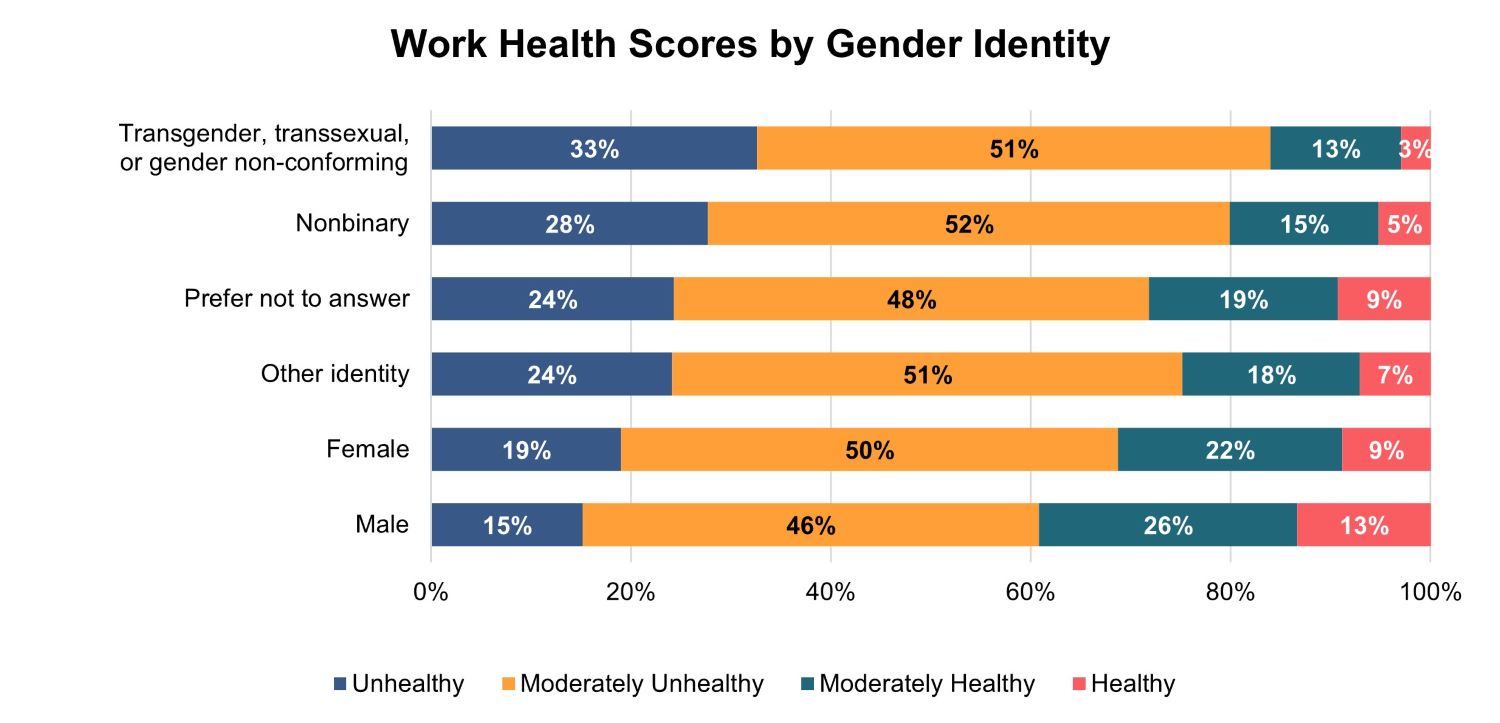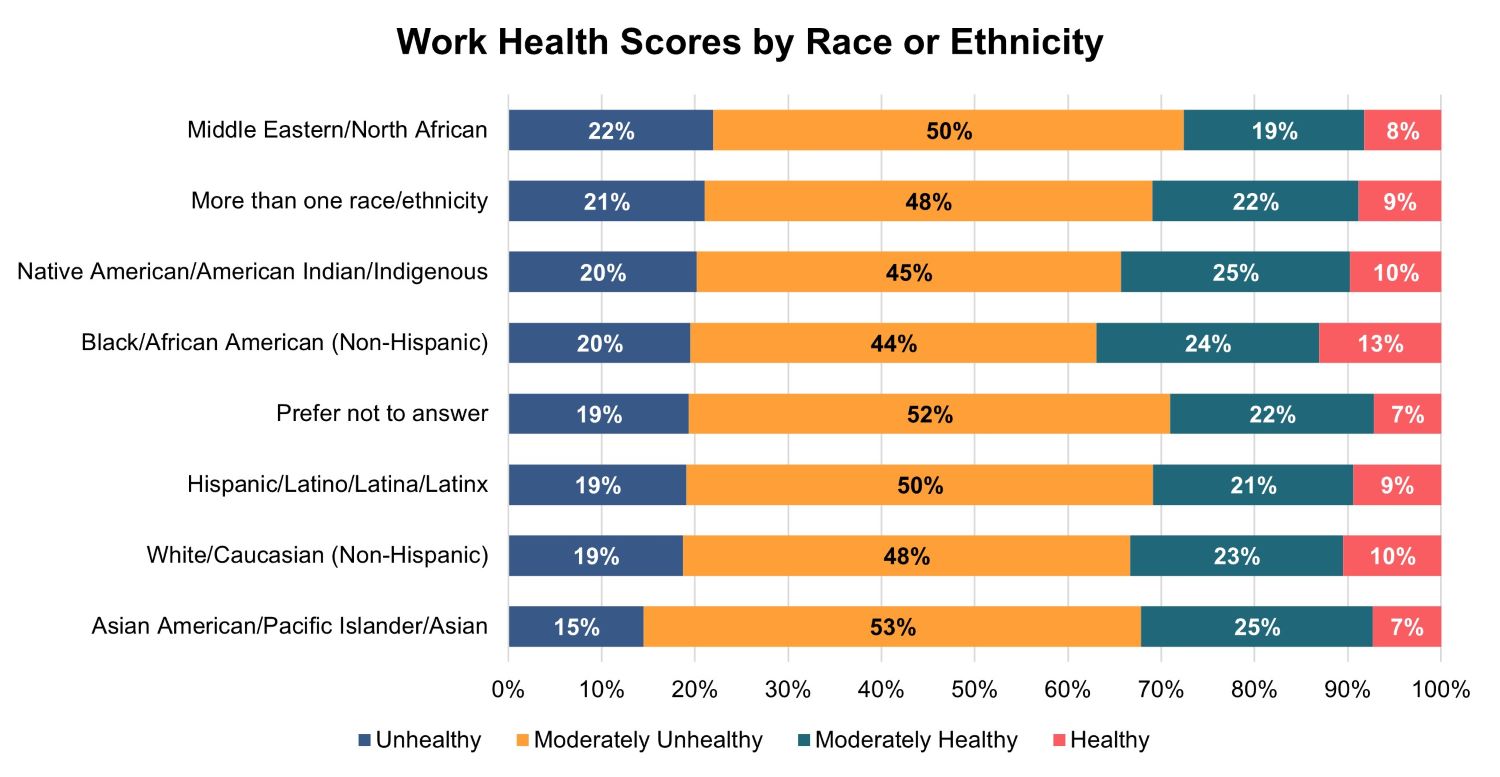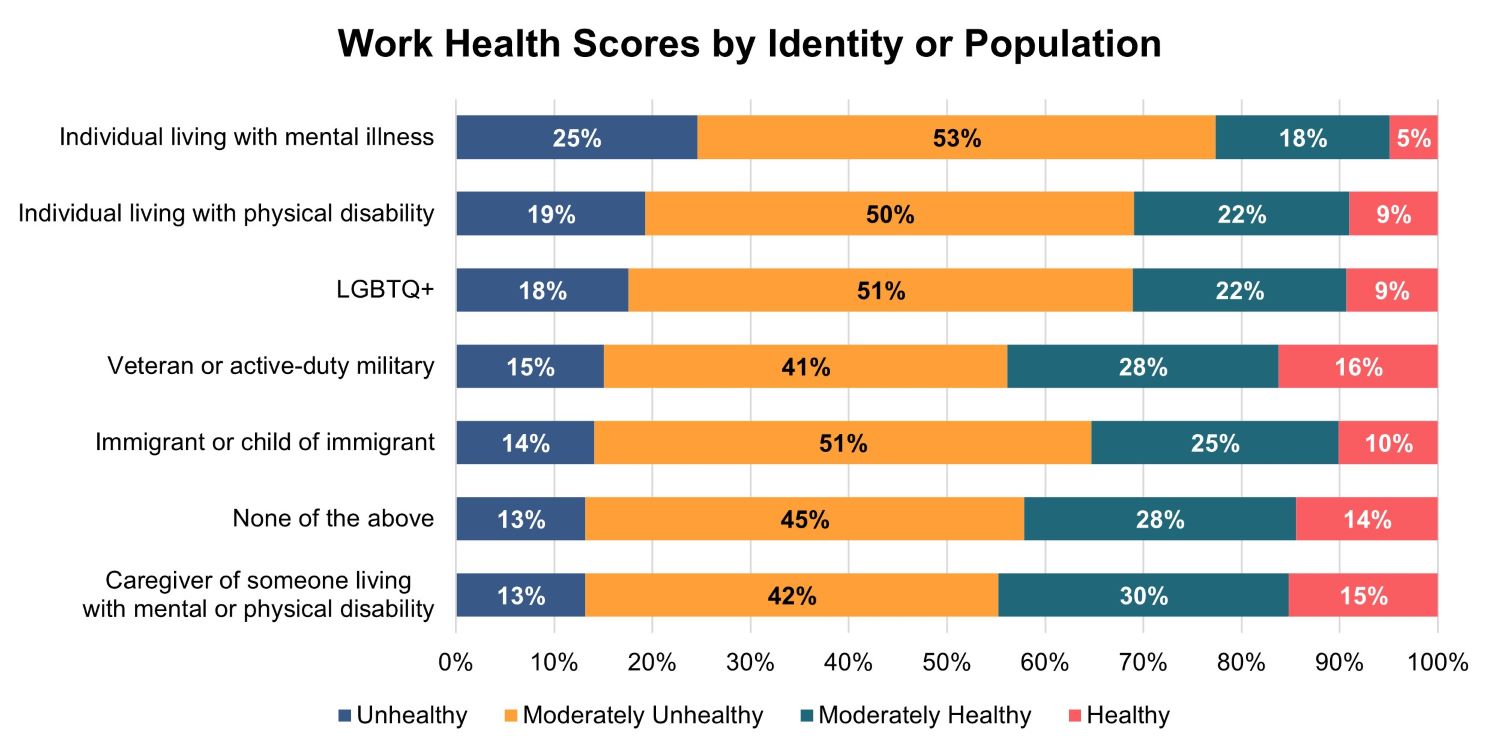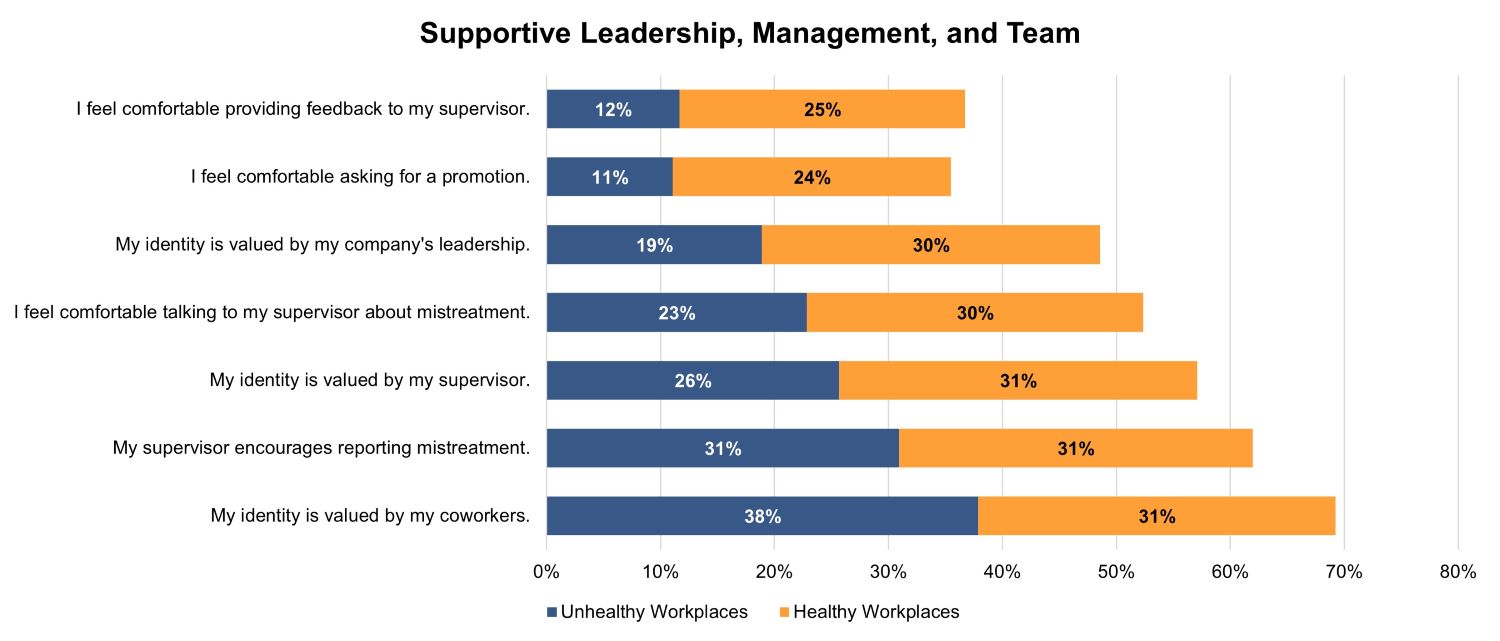2023 workplace wellness research

Our 2023 Mind the Workplace survey results show that workers thrive in a work environment where their identities are represented, acknowledged, valued, and trusted, particularly in a workplace where leadership and management demonstrate these values.
Executive summary
Many organizations have prioritized diversity, equity, and inclusion (DEI) through policies and programs. It’s a good start. Yet, these initial efforts in DEI are only a start if creating a mentally well workplace for all workers is the goal.
Evidence shows that improved worker health, increased employee engagement and retention, and decreased stress in the workplace are consistent outcomes found in organizations that are investing in creating psychologically safe and equitable work environments. Healthy workplaces recognize the importance of how an individual’s identity intersects with mental wellness, particularly for workers of marginalized or stigmatized communities.
Mental Health America’s annual work health survey helps determine the current state of worker mental health and well-being in the U.S. The survey also informs effective practices that support mentally healthy work environments. The latest work health survey measured the perceptions of 25,948 workers across 17 U.S. industries who shared their workplace experiences relating to their identity(s).
MHA aimed to answer and find solutions to the following questions:
- How does a worker’s identity relate to their mental health at work?
- How do microaggressions at work impact a worker’s mental health?
- What employer interventions contribute to a more inclusive workplace?
The findings reflect that workers thrive in a work environment where their identities are represented, acknowledged, valued, and trusted, particularly in a workplace where leadership and management demonstrate these values.
Fostering an inclusive work environment requires more than an equity statement and corporate diversity policy. A true workplace culture of inclusion needs the support of organizational leadership and management to not only address worker discrimination, microaggressions, and implicit biases but also strive for substantial improvements in workforce representation and psychological safety in physical, hybrid, and remote work environments.
Key findings
Mental health and psychological safety at work
- Workers who feel that their identity and perspectives are valued by leadership report higher rates of psychological safety. Of those who feel valued by leadership, 3 in 4 workers feel emotionally and mentally safe in their workplace (76%), report that their workplace takes direct actions to address discrimination (73%), and would recommend their workplace to their peers (76%).
- Workers who feel psychologically safe in their workplace strongly correlate with fewer bouts of unmanageable stress contributing to mental health concerns. Eighty-one percent of workers who feel mentally or emotionally safe in their workplace report that workplace stress does not affect their mental health. Workers in frontline positions feel less mentally or emotionally safe compared to people managers and leadership.
I am comfortable being me at my workplace.
- African American female survey respondent
- Workers in healthy work environments report experiencing fewer microaggressions related to race and gender identity. However, 3 in 5 workers still regularly experience microaggressions at work based on race, and 2 in 5 workers based on gender.
- Workers who do not feel that leadership values their identities perceive their organization as either complicit or harmful in cultivating a psychologically safe workplace. Of workers who do not feel valued by leadership, 73% feel that their company would not act on discrimination issues. In addition, 73% of workers are not comfortable talking to a manager about mistreatment based on race, gender, or disability, and 77% feel that their manager would not encourage them to report mistreatment.
- Workers in unhealthy work environments report higher rates of psychological distress that lead to mental health concerns. In 2022, 81% of workers report that workplace stress affects their mental health, compared to 78% of respondents in 2021. Seventy-three percent of workers report that workplace stress affects relationships with family, friends, or co-workers.
My supervisor has made it a toxic space for me, ignoring my suggestions [and] perspectives, speaking to me in a condescending manner, and deliberate gaslighting [and] manipulating me. Every performance conversation ends with me apologizing.
- African American male survey respondent
...My location is causing me psychological stress [and] to have anxiety and panic attacks on the way and during work. I asked for a transfer to be removed from the location, and I was denied and had to stay there. I feel I am being forced to quit. They didn't address my mental [health concerns] or advise of resources from the company.
- African American female survey respondent
This graph depicts the percentage of respondents who agreed with each statement or measure according to their total work health scores, indicating which practices or perceptions more often occur in healthy and unhealthy workplaces.
Workforce representation and inclusive workplace culture
- Workers who feel that their identity and perspectives are valued by leadership perceive their organization as invested in building a diverse workforce. Of workers who feel that leadership values their identity, 75% agree that their organization invests time and energy into building a diverse workforce, and 4 in 5 workers (81%) report that leadership has meaningful conversations about race, gender, or disability in the workplace.
My location's management...goes above and beyond to support and recognize the diverse identities in our workplace. If not for my co-workers and management, I would have probably left out of the feeling of being unwelcome, but I actually prefer to be at work than anywhere else some days.
- white transgender survey respondent
This graph depicts the percentage of respondents who agreed with each statement or measure according to their total work health scores, indicating which practices or perceptions more often occur in healthy and unhealthy workplaces.
- Individuals who identify as female, nonbinary, transgender, or gender non-conforming experience poorer worker mental health outcomes compared to the respondents who identify as male. In addition, these workers perceive organizational leadership as less diverse, do not feel that their identities are valued, feel less mentally or emotionally safe in their workplace, and would not recommend their workplace to their peers.
- Workers of certain racial or ethnic backgrounds experience poorer worker mental health outcomes compared to other surveyed populations. Middle Eastern and North African workers report the lowest work health scores with 22% of these workers in unhealthy work environments, followed by those who identify as more than one race or ethnicity at 21%, then by Native American or Indigenous workers at 20%.
- Workers who live with a disability experience poorer worker mental health outcomes compared to other surveyed populations. Workers who live with a mental health condition or physical disability report lower overall work health scores with 25% and 19%, respectively, in unhealthy work environments.
The support feels surface-level. I'm afraid if I were to speak up and advocate for myself as a disabled person, I would face retaliation or an even more uncomfortable work environment.
- white nonbinary survey respondent
This graph depicts work health scores, ranging from healthy to unhealthy, based on gender identity, race or ethnicity, and population or group.
- Larger organizations are perceived as more diverse, psychologically safe, and willing to address discrimination than smaller organizations. However, 69% of surveyed individuals represent organizations with fewer than 1,000 workers. According to the Bureau of Labor Statistics, over 58% of U.S. workers are employed at organizations with fewer than 1,000 workers.
Supportive leadership, management, and team
- Perceptions of organizational leadership and management have a greater influence on worker mental health outcomes than perceptions of peer or team dynamics. Workers who feel valued by leadership and their managers are more strongly correlated with mental health outcomes (r=0.374) compared to feeling valued by their co-workers or peers (r=0.253).
- Workers with supportive managers report higher rates of psychological safety. Of those who feel that their manager values their identity, 4 in 5 workers (84%) feel mentally and emotionally safe in their workplace; 78% are comfortable talking to a manager about mistreatment based on race, gender, or disability; 74% feel that their manager would encourage them to report mistreatment, and 84% would recommend their workplace to their peers.
My supervisor buffers me from administrative issues and ensures that I have the tools and support needed for my duties, and I feel supported on a personal level.
- white male survey respondent
- Workers with supportive managers are more comfortable asking for support and providing feedback to their managers. Of workers who feel that their manager values their identity, 85% are comfortable asking for a promotion, and 86% are comfortable providing feedback to their manager about their management style.
- Workers with unsupportive managers feel less psychologically safe in their workplace. Of those who do not feel comfortable providing feedback to their manager, 83% of workers do not feel mentally or emotionally safe in their workplace, and 82% would not recommend their workplace to their peers.
There are no ways of addressing the mental stress induced by my supervisor. I love the job, but having the right manager who is a genuine leader that cares for people is very important. The organization does not provide any avenues to provide feedback for managers.
- Asian American male survey respondent
This graph depicts the percentage of respondents who agreed with each statement or measure according to their total work health scores, indicating which practices or perceptions more often occur in healthy and unhealthy workplaces.
Recommendations for employers
Do more to support workers of marginalized or stigmatized communities and their well-being by contributing to a workplace culture in which their identities are represented, acknowledged, valued, and trusted.
Many organizations list nondiscrimination policies in the employee handbook—often never reviewed again after new hire orientation. In addition to the handbook, these values should be expressed on the organization’s website, intranet, job postings, and training materials so new and existing staff can easily find and consider how these values align with their own.
The values should guide and be at the forefront of every organizational decision, operating procedure, training, and interpersonal interaction. Workers want to feel they can bring their “whole selves” to work, and actions will speak louder than words alone.
If organizational leadership is homogenous and lacks representation, all stated values or commitments to diversity will be perceived as superficial and performative. Analyze your organization’s power and gatekeeping system and how power dynamics influence hiring and recruitment. All levels of an organization, including leadership, should model the values and inclusive culture they aspire to achieve.
Consider each worker as an investment and provide compensation, benefits, and programs that allow workers to thrive in their personal and professional lives. Happy workers are more loyal to an organization that invests in their growth, which ultimately benefits the bottom line. BIPOC workers are less likely to benefit from generational wealth and social safety nets than their White counterparts. They may also have higher expenses due to systemic financial inequities, including legacies of redlining, predatory lending practices, and higher student debt. Workers paid a thriving wage will likely have less financial stress, improved job performance, and increased organizational loyalty.
BIPOC and female workers still earn less than their White male colleagues performing similar job functions. Consider a clear and transparent compensation structure and procedure to determine salary ranges for each position and how salary increases are given for promotions, recognition awards, or cost-of-living adjustments (COLA).
Suppose a predominantly White or homogenous group determines standard dress, hair, or behaviors. In that case, marginalized workers may feel uncomfortable bringing their authentic selves to work. They may code-switch their manner of presentation to keep their colleagues comfortable. Keeping others comfortable by minimizing or hiding one’s identity comes at an emotional cost, so ensuring all workers feel comfortable being themselves is critical.
A cut-throat competitive work environment alienates workers who may feel like, or be seen as, outsiders due to racial or cultural differences. A collaborative work environment that often recognizes the individual accomplishments of workers and teams (which promotes healthy competition) encourages teamwork and relationship-building, creating a more inclusive culture.
BIPOC workers often work harder and are exceptional to achieve the same recognition as their White counterparts, leading to BIPOC individuals overworking as a means of survival, increased stress and burnout rates, and feelings of discontent. An employer that provides and encourages PTO usage levels the playing field for all workers. Encourage workers to completely disengage from work when they are on vacation and allow them time when they return to catch up before adding additional responsibilities.
Affinity groups can offer respite to workers in underrepresented groups. However, affinity groups should not be the sole source of support for workers or set the expectation that affinity groups alleviate the responsibility of promoting DEI policies and practices from leadership or other members of an organization.
Individuals who identify as women are routinely interrupted, dismissed, or spoken over in meetings. Draft a meeting “agreement” to ensure no one person dominates the floor and everyone’s voice is heard. If a person violates the agreement, remind them of the agreement and ensure other workers have the opportunity to share.
Many employers offer recognition of Christmas or Easter as paid holidays but do not provide equivalents for other religious or spiritual days. Some organizations implement “floating holidays” to allow workers to take paid time off to celebrate their chosen holidays.
A public shooting targeting a specific demographic of people might impact your workers who identify with the victims. In response, offer non-intrusive ways to support them, including offering time away from work – individuals may not want to process their feelings at work. Acknowledge – do not ignore – the event, and provide workers who want to connect a safe, confidential space to meet. Ideally, have a compassionate and knowledgeable individual facilitate the process and respect each worker’s decision on whether or not to participate. Remind workers of the organization’s resources, including an employee assistance program (EAP) or telehealth options. Finally, respect that secondary trauma affects individuals and how they process those feelings differently.
No one worker should be the face or voice of an entire group. If only one or a few individuals represent an entire group, their “otherness” invariably comes to the forefront. Workers are less likely to feel tokenized when their colleagues and peers are diverse. Additionally, research demonstrates that a diverse workforce contributes to better financial outcomes.
Educating others about DEI is an emotionally, mentally, and socially taxing challenge, so employers and all staff must take responsibility for cultivating a culture mindful of these ideals. The exceptions might be when workers request to take on this task, or it is an explicit function outlined in their job description.
The content of this webpage is the property of Mental Health America. MHA grants a limited license to use the webpage, or portions thereof, only if, whenever the webpage is used in written or electronic form, it is clearly stated that the website was created by and is the property of Mental Health America and a link is provided to www.mhanational.org. Under no circumstances may the website be used for any commercial purpose without the express written permission of Mental Health America. For permission to use the content of this webpage, please contact workplace@mhanational.org.
Frequently asked questions
The 2022 Work Health Survey launched in August 2021. It was available to the public through MHA’s online mental health screening website. The survey included 21 items selected as measures for workforce representation, inclusive culture, supportive management, psychological safety, and mental health and illness in the workplace. The Work Health Survey collected 25,948 U.S.-based responses in 12 months (August 2021 – August 2022).
Survey responses were scored on a 1-6 Likert scale: 1 – Strongly Disagree, 2 – Disagree, 3 –Somewhat Disagree, 4 – Somewhat Agree, 5 – Agree, 6 – Strongly Agree. Inverse scoring was used for negatively worded statements. For example, in the statement, “I feel mentally or emotionally safe in my workplace,” one point is assigned for every “Strongly Disagree” response and six points for every “Strongly Agree.” For the question, “My workplace stress affects my mental health,” six points were assigned to every “Strongly Disagree” and one point to every “Strongly Agree.” Lower scores indicate an unhealthy workplace. High scores indicate a healthier workplace. The final score for each respondent represented the sum of all ratings, while the average was determined by a collective sum divided by all respondents.
Correlation coefficients were computed for each question. Question 6 (“My identity and perspectives are valued by my company’s leadership”) and Question 17 (“I would recommend my workplace to my peers”) had the strongest correlation (r=0.631). Question 1 (“My company’s workforce is diverse”) and Question 18 (“My workplace stress affects my relationships with family, friends, or co-workers”) had the weakest correlation (r=0.123).
In addition, the sum of each respondent’s responses was categorized into the following quartiles: unhealthy (overall Work Health Survey score is between 0 and 45) at 18 percent of survey respondents, moderately unhealthy (score between 46 and 75) at 49 percent, moderately healthy (score between 76 and 95) at 23 percent, and healthy (score of 96 or more) at ten percent, to compare the top 25% of healthy and bottom 25% of unhealthy workplaces in each section. Overall, the average workplace score was 65.91, the median 64, and the mode 64.
MHA’s 2022 Work Health Survey respondents were likely to find the survey when searching for mental health support through mhascreening.org. The sample weighs heavily among users experiencing other mental health concerns or experiencing problems with work that might exacerbate mental health concerns. Rather than reflecting the general population, MHA’s survey respondents represent workers at risk of burnout and poor worker well-being. The convenience sample allows MHA to evaluate the challenges and opportunities that will impact those with the highest needs.
MHA’s Work Health Survey helps determine the current state of worker mental health and well-being in the U.S. The 2022 survey asks about gender, race, and disability concerning the workplace. Individuals were asked to rate each question/statement below using the following scale: Strongly Disagree, Disagree, Somewhat Disagree, Somewhat Agree, Agree, Strongly Agree.
- My company’s workforce is diverse.
- My company’s leadership is diverse.
- My company invests time and energy into building a diverse workforce.
- My identity and perspectives are valued by my supervisor.
- My identity and perspectives are valued by my co-workers or peers.
- My identity and perspectives are valued by my company’s leadership.
- My supervisor care about having meaningful conversations about race, gender, or disability in the workplace.
- My co-workers or peers care about having meaningful conversations about race, gender, or disability in the workplace.
- My company’s leadership care about having meaningful conversations about race, gender, or disability in the workplace.
- I feel comfortable asking for a promotion (change in job duties or title) in my current workplace.
- I feel comfortable providing feedback to my supervisor about their management style.
- If I was mistreated because of my race, gender, or disability, I would feel comfortable talking to my supervisor or team about it.
- If I was mistreated because of my race, gender, or disability, my supervisor or team would encourage me to report it.
- I regularly experience microaggressions at work. Microaggression is defined as indirect, subtle, or unintentional discrimination against members of a marginalized group.
- My company takes direct actions to address discrimination in the workplace. Discrimination is defined as the unjust or prejudicial treatment of members of a marginalized group.
- I feel mentally or emotionally safe in my workplace.
- I would recommend my workplace to my peers.
- My workplace stress affects my relationships with family, friends, or co-workers.
- My workplace stress affects my mental health (i.e., anxiety, depression, substance use).
- I am actively looking for a new position.
- Tell us how your workplace is supportive or unsupportive. (Optional)
Survey respondents were asked to indicate their gender identity, racial/ethnic group(s), specified populations or identities, employer size, position, and industry.






